Channel Letters: Designing for LED illumination
by all | 26 July 2017 10:25 am
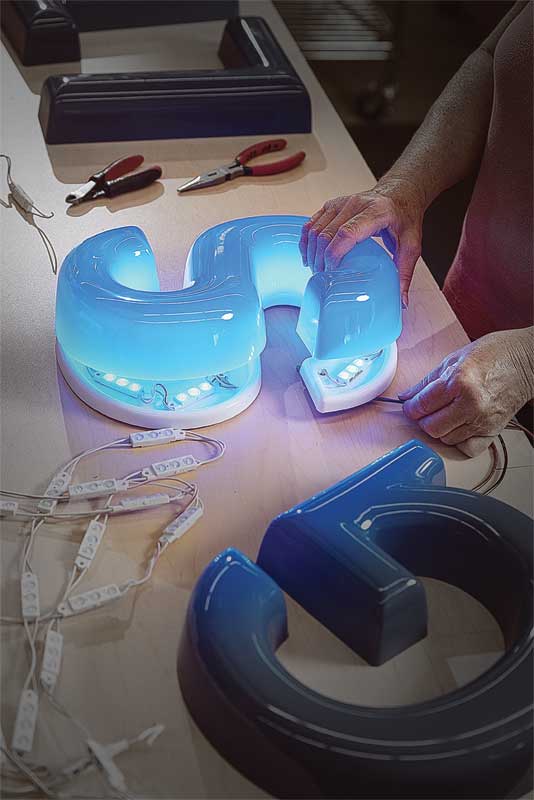 [1]
[1]Photos courtesy Gemini
By Tim Bauer
Sign designers and specifiers now have more ways than ever to add dramatic lighting effects to their creations. Gone are the days where illuminated signs had to be produced with metal cans at least 127 mm (5 in.) deep to allow sufficient space for high-voltage neon lighting and wiring. With today’s widespread availability of light-emitting diodes (LEDs), the landscape for channel letters has been revolutionized. Much shallower designs are now possible, down to 38 mm (1.5 in.) deep for face-lit letters and less than 25 mm (1 in.) deep for halo-lit letters, in a variety of metal or plastic materials.
Visual context
When designing an illuminated sign, there are a number of factors to consider and evaluate throughout the process.
For one thing, there should be a full review of the planned installation site. There may be local factors, such as space restrictions or existing lighting in the surrounding area, that could negatively impact the visibility of the sign.
The context of the installation site will also determine whether the sign will be viewed up close or from a distance. The channel letters will need to be sized and spaced properly to ensure they are easily readable. To further increase legibility, the colour of the mounting surface should be contrasted strongly with the colours of the letters.
Another factor is how much of the sign will be directly illuminated. Some letters might be face-lit while others are halo-lit, for example, or perhaps only specific areas will need to be lit at all.
All of these considerations will help identify the optimal materials to use for the sign and how best to illuminate it, with which types and colours of LEDs.
Materials and finishes
Illuminated sign faces can be specified with translucent materials in any desired colour or with so-called ‘day/night’ acrylic, which—as the term suggests—allows channel letters to showcase one colour by day and another by night. For more detailed designs, sign faces can be printed with special translucent inks, applied with vinyl or coated with translucent paints for illuminated portions and opaque paints or vinyl for unlit portions.
For a halo-lit design, the faces can be nearly any type of metal or pigmented plastic finish. They can also be printed, applied with vinyl or painted in any combination of colours.
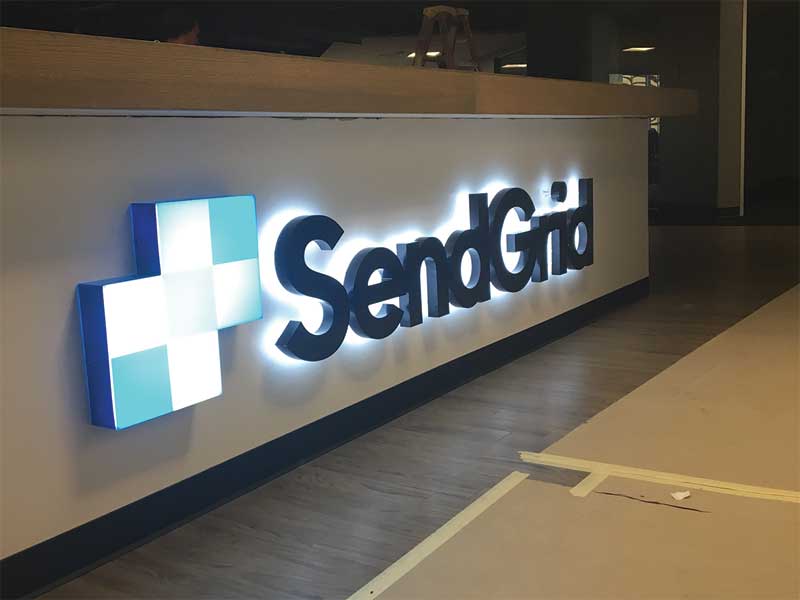 [2]
[2]Channel letters need to be sized and spaced properly to ensure they are easily readable within the context of their installation site.
With this freedom, the designer’s primary focus should be identifying which colour, finish and illumination will work best for the sign, given the surrounding visual context, to achieve the desired look.
Halo-lighting considerations
If the surface of an installation site for halo-lit letters is dark and glossy, it will absorb light and create a mirror effect with the LEDs. A matte sheen with proper colour contrast, on the other hand, can support a stronger halo effect.
Another question is how far the letters should stand off of the surface. The closer they are to the wall behind them, the less lighting will be emitted around the perimeter of the letters, thus limiting the intended effect.
The best halo illumination effect is produced with a letter-to-wall distance of about 38 mm (1.5 in.), i.e. the minimum depth for a face-lit sign, but the designer will need to decide just how wide and bright an illuminated outline is desired around each letter or other visual component and around the sign as a whole. The spacing between the letters may need to be adjusted, for example, to prevent the appearance of the letters ‘blending’ when lit.
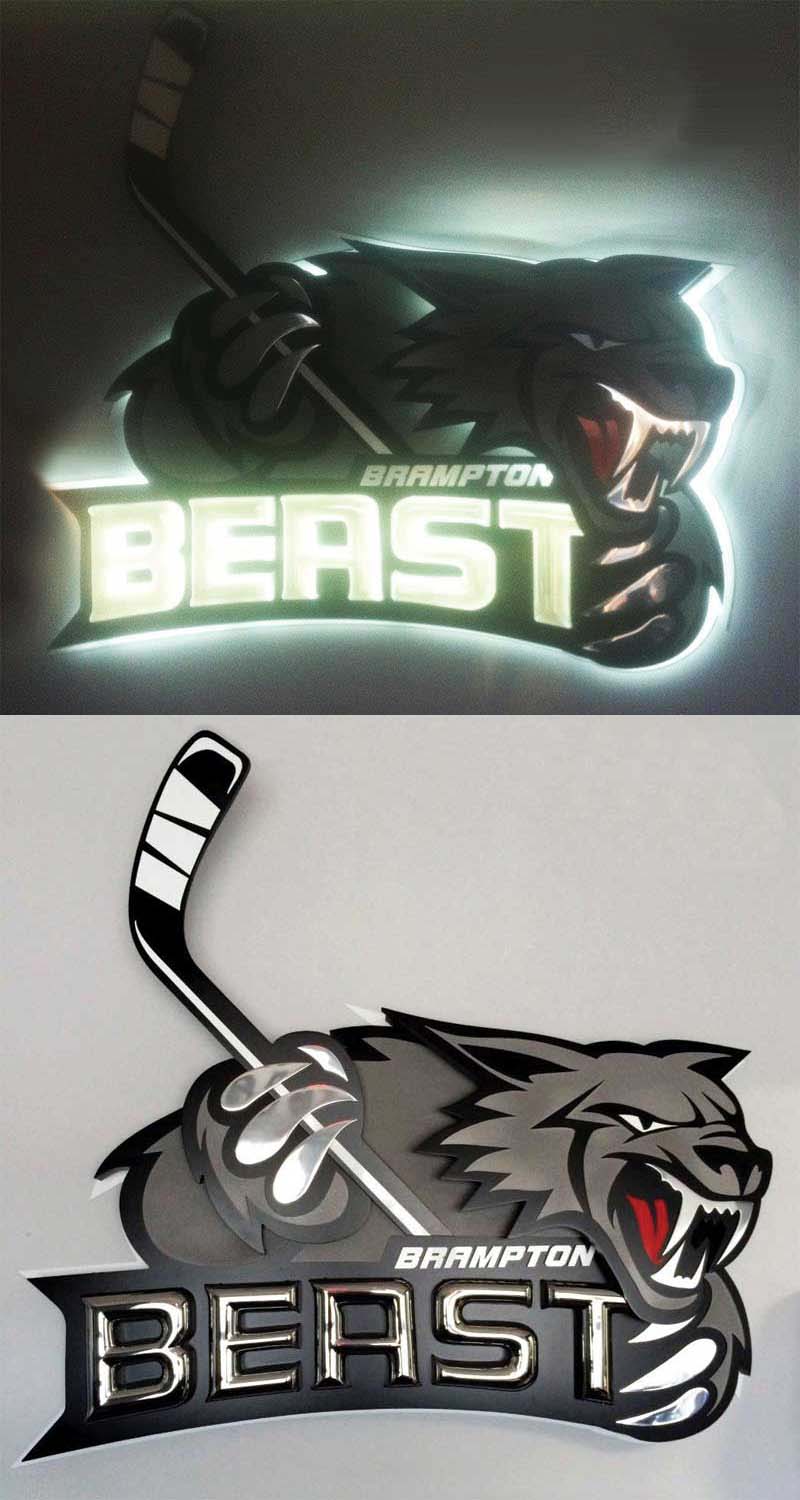 [3]
[3]With some signs, only specific areas are illuminated, for dramatic effect.
Choosing LEDs
The LED modules used in signs are typically 12-V direct current (DC) systems, approved by Underwriters Laboratories (UL). While some are intended to populate large sign panels, others are engineered with wider viewing angles to help light smaller, more compact spaces, including narrow channel letter strokes.
Thus, the design of a sign will dictate which types of LEDs should be used to illuminate it. LED selection is a matter of identifying the correct light intensity and viewing angle.
As for colour, the LED’s wavelength should be matched to that of the translucent plastic letter, in the case of a face-lit application, or to the desired halo appearance.
The same LEDs can certainly be used for a broad variety of applications, but it is best to consult with suppliers to find out which will be best for a specific design.
Metals and plastics
LEDs can be installed effectively within a wide variety of UL-recognized materials, including—but not limited to—the following:
- Fabricated metals: aluminum, brass, bronze, copper, stainless steel or titanium-coated stainless steel.
- Cast metals: aluminum or bronze.
- Plastics: cellulose acetate butyrate (CAB)
or acrylic.
There are advantages to using some of these materials over others. If a sign design calls for the use of plastic cans, for example, it will be important to select specific LEDs that do not require a metal can to serve as their ‘heat sink.’ It will also be important to choose a plastic—such as CAB—that is already approved for use in illuminated signage.
Fabricated metals
With fabricated metals, there are many options for channel letters, from thin-gauge trim-cap aluminum to welded or soldered premium-gauge aluminum, stainless steel (including the titanium-coated variations), brass, copper and bronze, all of which can provide a more elegant, sophisticated appearance than plastic, for both day and night viewing.
Trim-cap aluminum channel letters are typically face-lit and 76 or 127 mm (3 or 5 in.) deep. They are produced with 1-mm (0.04-in.) or 1.6-mm (0.06-in) aluminum returns, which are typically finished with paint, and feature riveted or stapled backs and trim cap attached to translucent plastic faces. While they may not appear highly robust from up close, they provide a good option for economical signage that can be produced quickly.
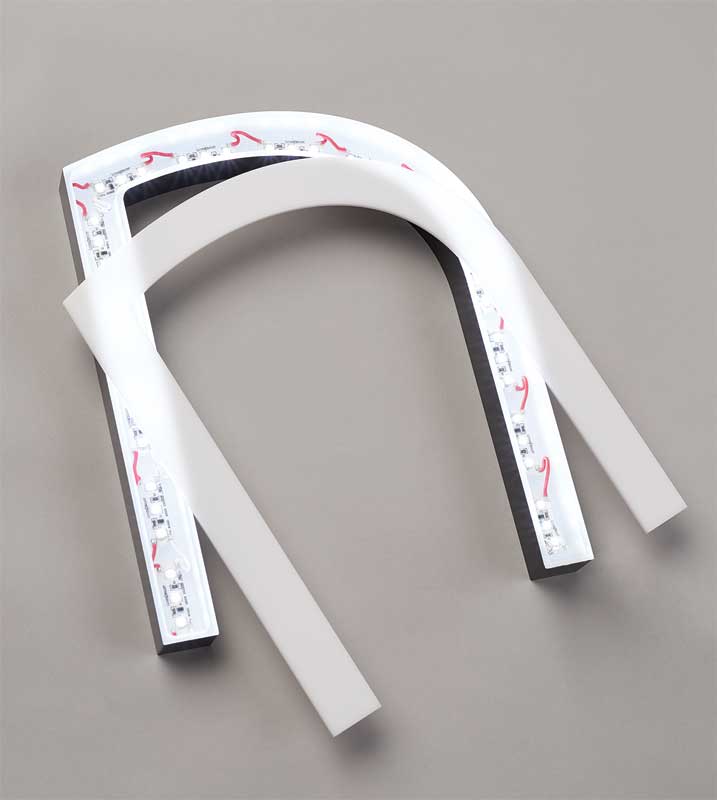 [4]
[4]With the space-efficient nature of LEDs, a return depth of just 38 mm (1.5 in.) is possible.
Premium-gauge aluminum channel letters are welded, face- or halo-lit and available in standard depths ranging from 51 mm (2 in.) to 152 mm (6 in.), with greater depths available for special projects. The material is sufficiently strong for channel letters that are 0.4 to 3 m (16 to 120 in.) tall or even larger. For face-lit applications, a ‘shoebox’ cover can be produced from the same gauge aluminum as the can, with a narrow outline to hold the translucent plastic face in place. This cover overlaps the can and is attached with screws to provide sharp, crisp corners, ensuring both a distinguished daytime look and an elegant night viewing appearance. There are also ‘trimless’ face-lit applications, i.e. where the edge of the face is illuminated along with the rest of it. There are painted, brushed and anodized finishes available for face- and halo-lit aluminum letters.
Premium stainless steel letters are best produced with a continuous bead of solder around the inside perimeter of their faces. They can be face- or halo-lit at a wide variety of depths, from 25 to 152 mm (1 to 6 in.).
Stainless steel letters can be produced as small as 51 mm (2 in.), but due to the size limitations of LED modules, they are typically required to be at least 152 mm (6 in.) for illumination. For face-lit applications, a narrow outline is required within the design to secure the translucent plastic face in place. Like premium-gauge aluminum, stainless steel provides sharp, crisp corners and trimless face applications are also available. Polished, brushed, titanium-coated and painted finishes are the most popular options.
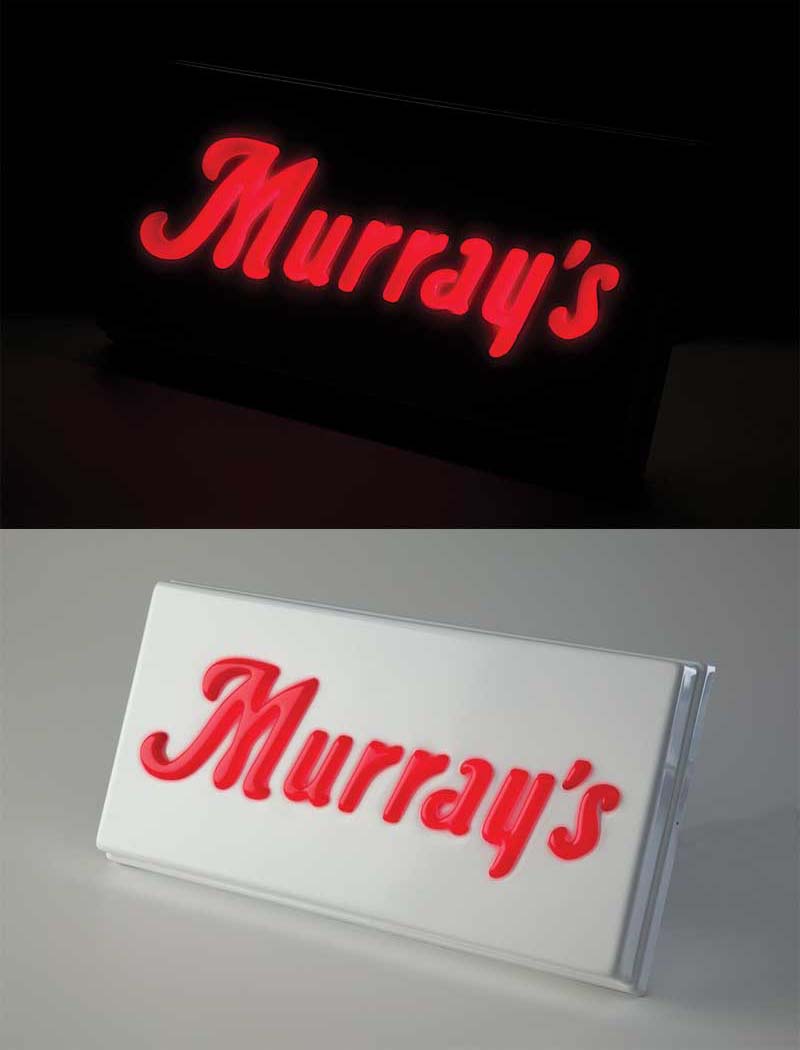 [5]
[5]Smaller letters with very narrow strokes can be produced as raised, illuminated characters integral to the face of a sign panel.
Cast metals
Both cast aluminum and bronze have been traditional choices for letters, logos and plaques, as they convey a sense of sophisticated quality and permanence for banks and other institutions, but LEDs have helped update them with halo lighting for better nighttime visibility. Cast metal letters are produced with a ‘cavity’ in the back for the lighting modules, with a protective rear panel easily added. They can also be custom-designed for special projects. A halo effect is possible at a depth from 13 to 76 mm (0.5 to 3 in.) or greater. A wide variety of painted, brushed, anodized, oxidized, patina and polished finishes are available.
Plastics
Illuminated CAB letters are thermoformed with a slight edge radius. They are produced with a two-part construction—i.e. faces and cans—and can be face- or halo-lit. For face-lit letters, a partially illuminated return will create a dramatic effect.
CAB is easily customizable to create letters, logos and panels as small as 230 mm (9 in.) tall. The shallowest depth for proper lighting with LEDs is approximately 51 mm (2 in.). The physical size of the LED modules and the thickness of the plastics are the main factors limiting the size of individual letter strokes, but they can be as narrow as 25 mm (1 in.). Smaller letters with very narrow strokes can be produced, but instead of being individually mounted characters, they can be raised, illuminated characters integral to the face of a sign panel. Intricate designs and accents can be created by adding vinyl or printed graphics to the face.
Illuminated acrylic channel letters provide a high-end but low-profile appearance. They can be produced by precision machining or fabricating cast translucent acrylic.
Precision-machined acrylic offers a refined, sharp edge, trimless face and well-diffused light for letters and logos as small as 203 mm (8 in.) and up to 711 mm (28 in.). In addition to the face or back being lit, a 4.8-mm (0.19-in.) plate edge is illuminated for a more dramatic effect. Stroke widths can vary from 22 to 127 mm (0.87 to 5 in.).
Fabricated acrylic further extends the trimless look by supporting face, halo and/or return illumination. Pieces are precision-routed and hand-fabricated with buffed edges and range from 305 to 914 mm (12 to 36 in) tall and 33 to 102 mm (1.5 in to 4 in) deep. Letter strokes can be as narrow as 38 mm (1.5 in) and as wide as 457 mm (18 in) when illuminated.
The versatility of LEDs
LEDs can be used in channel letters in many ways, from populating recessed cavities to integrating with polycarbonate backings, from diffusing light with acrylic through the face and returns to securing lights to white backs with double-faced tape and hold-down blocks. And as LED products continue to evolve, they will be able to support even more options for illuminated sign design. The possibilities will only expand further.
Tim Bauer is the sign product manager for Gemini, which manufactures dimensional letters, logos and plaques for sign professionals. For more information, contact him via e-mail at tim.bauer@geminisignproducts.com[6].
- [Image]: https://www.signmedia.ca/wp-content/uploads/2017/07/LightingGemLite.jpg
- [Image]: https://www.signmedia.ca/wp-content/uploads/2017/07/Install_SendGrid.jpg
- [Image]: https://www.signmedia.ca/wp-content/uploads/2017/07/edit1-1.jpg
- [Image]: https://www.signmedia.ca/wp-content/uploads/2017/07/Luxe_n.jpg
- [Image]: https://www.signmedia.ca/wp-content/uploads/2017/07/edit2.jpg
- tim.bauer@geminisignproducts.com: mailto:tim.bauer@geminisignproducts.com
Source URL: https://www.signmedia.ca/channel-letters-designing-for-led-illumination/